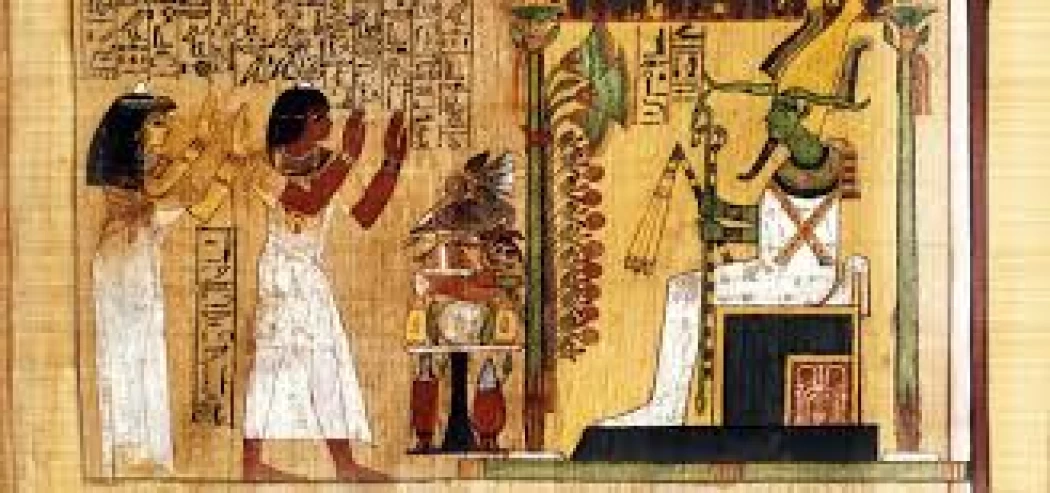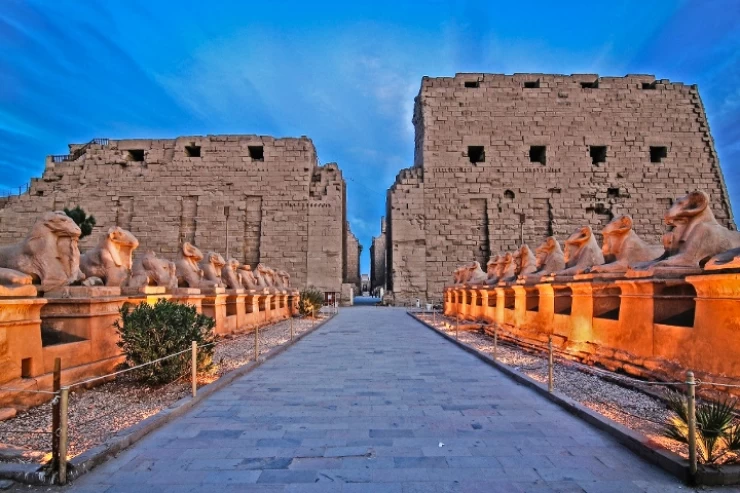
Das Buch der Toten | Altägyptischer Grabtext
Darin befanden sich Grabtexte verschiedener Art, sowohl magisch-religiöse Formeln als auch Geschichten, mit deren Hilfe der Verstorbene die unzähligen Prüfungen überwinden konnte, denen er auf dem langen und kurvenreichen Weg begegnen würde, der ihn zur Gegenwart von Osiris führte. Die Texte hätten ihm daher geholfen, sowohl ohne besondere Probleme zum Todesgott zu gelangen als auch das sogenannte Zeugnis seines irdischen Lebens vorzubereiten, dessen Prüfung Osiris gehörte.
Das Totenbuch hat im Laufe der Zeit verschiedene Formen angenommen. Anfangs wurden tatsächlich Formeln und Geschichten in die Wände des Grabes eingraviert, nur um direkt in den Sarkophag eingraviert zu werden. Dynastie (1543-1292 v. Chr.) änderte das Totenbuch seine Form erneut: Die Bestattungstexte wurden auf Papyrus übertragen und dann zusammen mit dem Verstorbenen und all den Gegenständen, die auf seiner letzten Reise nützlich sein könnten, in einem Sarkophag verschlossen.
Diese magischen Formeln, die nach Überzeugung in Gräber gelegt wurden, schützten und halfen den Verstorbenen in der Unterwelt, und sie enthalten Hymnen an den Gott Amun Re, den Gott der Sonne. Wir können Beschreibungen von Zaubersprüchen auf den Gängen und Wänden von Gräbern, auf den Verpackungen von Mumien und sogar in der goldenen Maske von König Tutanchamun sehen.
Das Totenbuch erschien zuerst im Neuen Königreich, aber sein Text entwickelte sich aus einer langen Geschichte magischer Bestattungsschriften. Die ältesten von ihnen, die Pyramidentexte, waren nur den Ägyptern zugänglich. Dann entwickelten sie sich zu Sargtexten - einer modifizierten Version der Pyramidentexte -, die auf Särge geschrieben und in die Gräber nicht königlicher Personen wie reicher Ägypter und Vertreter der Elite aufgenommen wurden.
Osiris war der Gott der Auferstehung, und Re war der Sonnengott, ein Stern im Totenbuch. Dann wenden sich 42 weitere Götter an den Richter. Obwohl der Text selbst in Inhalt und Reihenfolge variiert, ist die Geschichte normalerweise in vier Hauptabschnitte unterteilt: Der Verstorbene betritt die Unterwelt und erlangt die physischen Kräfte der Lebenden zurück, der Verstorbene erwacht wieder und geht jeden Tag wie die Sonne auf, er reist durch den Himmel vor dem Gericht in der Unterwelt der Götter und findet schließlich eine Seele.
Reisen Sie nach Ägypten, um ägyptische Tempel und Pyramiden zu besuchen und mehr über die Mythologie und Hunderte von Göttern zu erfahren, die von den Pharaonen verehrt wurden, die den Menschen sehr ähnlich waren, sie liebten und hassten, eifersüchtig waren, kämpften und starben während eines erstaunlichen Mythos voller freudiger, aktiver und dramatischer Ereignisse, die moderne Filmemacher und Produzenten dazu inspirierten, weltberühmte Filme über die Größe der Pharaonen und die Götter, die sie anbeteten, zu schaffen. Nehmen Sie sich ein paar Tage Zeit, um Abydos, Gizeh, Luxor und Assuan zu besuchen, um die Gräber der Pharaonen zu sehen, die mit sehr klaren, detaillierten und wunderschön gemalten Szenen verschiedener Gottheiten des alten Ägypten sowie vielen anderen Orten, Städten, Abenteuern und Aktivitäten dekoriert sind Kairo, Sie können versuchen, eine unserer Touren nach Ägypten und Ägypten-Touristenpakete zu buchen viele private Gruppen mit einem Führer Kairo Tagestouren vom Flughafen und Ägypten Tagestouren Um die Hauptstadt Ägyptens, Kairo, zu erkunden, können Sie sich viele Ägypten-Reiserouten ansehen oder eine unserer ganztägigen Kairo-Touren unternehmen, wie:
- Reiserouten in Ägypten / Routen in Ägypten.
- Touren nach Assuan / Ausflüge nach Assuan / Tagestouren nach Assuan / Besichtigungstouren nach Assuan.
Inside were funerary texts of various kinds, both magico-religious formulas and stories, with the help of which the deceased could overcome the countless trials that he would face on the long and winding path that led him to the presence of Osiris. The texts, therefore, would have helped him both to reach the god of death without any special problems, and to prepare the so-called testimony of his earthly life, the trial of which belonged to Osiris.
The Book of the Dead has taken various forms over time. Initially, indeed, formulas and stories were engraved on the walls of the tomb, only to be engraved directly on the sarcophagus. Over time and until the eighteenth dynasty (1543-1292 BC), the book of the dead changed its form again: the funeral texts were transferred to papyrus, then closed in a sarcophagus along with the deceased and all those objects that could be useful in his last journey.
These magical formulas placed in tombs, according to beliefs, protected and helped the deceased in the underworld, and they include hymns to the god Amun Re, the god of the sun. We can see descriptions of spells on the passages and walls of tombs, on the wrappers of mummies and even inside the golden mask of King Tutankhamun.
The Book of the Dead first appeared in the New Kingdom, but its text evolved from a long history of magical funeral writing. The most ancient of them, the Pyramid Texts, were accessible only to the Egyptians. Then they evolved to Coffin Texts - a modified version of the Pyramid Texts - which were written on coffins and included in the tombs of non-royal persons, such as rich Egyptians and representatives of the elite.
As for the history of the writing of the Book of the Dead, the Pharaohs wrote down the Book of the Dead during the era of the construction of the Great Pyramid, and a copy of it is still preserved in the British Museum. It contains invocations to the gods, hymns, and prayers. Then there is a description of the reckoning that the souls of the dead encounter in the afterlife and the punishment and reward that befalls them.
The Pharaohs built huge temples in addition to tombs that were no less magnificent and luxurious, as they believed in resurrection and the return of the soul, which they depicted in two close images, "Ka" or "Ba." They were also keen to place all the things related to the deceased, including food, jewelry, and everything he loved in his life, with him in his tomb, where the soul of the deceased could eat and drink from it when it returned to the body, and before seeking the afterlife.
The ancient Egyptians knew religious literature since the dawn of history, and their holy books varied, most of which were about death and the afterlife. Their books usually contained a group of religious texts that expressed the Egyptians' perception of the life of the dead in the afterlife, and included a group of spells that were recited when preparing the body for burial.
Perhaps the ancient Pharaohs amazed the world with the diversity of these texts, and their abundance of ancient religious spells and literature, which remained an icon no less important than the remaining monuments from the Pharaonic eras, such as temples, royal tombs, and obelisks. Among these books' most significant works are:
Book of the Dead
Pyramid texts
The Book of Two Paths
The Guide's Book
Spell No. 125 is one of the most famous texts of the Book of the Dead. Even those unfamiliar with the book, and those unfamiliar with Egyptian mythology, know about the spell without realizing it. It is the incantation describing the trial of the deceased's heart in the Hall of Justice by the god Osiris, and is one of the most famous known images from ancient Egypt, although the god with his scale is not actually described in the text. Given the importance of the deceased passing the test of his heart weight in order to pass into bliss, knowing what to say and how to act in the presence of Osiris, Thoth, Anubis and the forty-two judges was the most important information with which the deceased could reach the afterlife.
After death, Anubis guides the deceased to the Hall of Justice (also known as the Hall of Two Truths), where the deceased will make the Confession of Absolution (also known as the Declaration of Innocence). This Confession of Absolution was a list of forty-two sins that the individual could honestly deny never to commit. Once made, Osiris, Thoth, Anubis, and the Forty-Two Judges consulted.
If the confession was accepted, the deceased's heart was weighed in a balance against the white feather of Maat, the feather of truth. If the deceased's heart was lighter than the feather of Maat, their soul passed to Heaven; if it was heavier than the feather, the heart was thrown to the ground, where it was devoured by the divine monster Ammut, and its owner's soul ceased to exist.
Spell 125 begins with an introduction to the reader (i.e., the soul of the deceased): "What to say upon arrival at the Hall of Justice"















